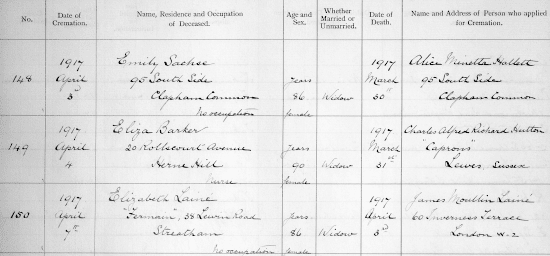Deceased Online is delighted to be adding 90,000 records to its database this week with the collection of cremation records from West Norwood and Lambeth Crematoria in south London.
 |
| Sir Henry Doulton's mausoleum with crematorium in the background (c) Matt Brown/Wikipedia |
 |
| Above: the impressive entrance to West Norwood cemetery and crematorium grounds |
West Norwood Crematorium lies on the site of the 'Magnificent' West Norwood Cemetery in south London, close to Tulse Hill, Dulwich, Streatham, and Brockwell Park.
This beautiful crematorium has been awarded a Green Flag award for the joint effort of community and council in restoring the unique heritage and ecological aspects of this environmental asset.
Last year marked hundred years of cremations in this part of south London. The opening of the crematorium, two years into the Great War, was noted in several newspapers, including the Hastings and St Leonards Observer 6 May 1916 (p.8).
Work began on the crematorium in 1915, when West Norwood Cemetery's Nonconformist Chapel was adapted for use of cremation. Working on behalf of the South Metropolitan Cemetery (as the cemetery was then known), Parisian company, Toisai Fraudet installed the gas furnaces in early 1916. The crematorium sits on the highest point of the West Norwood site.
During the Second World War, both the nonconformist and the Anglican chapels of the cemetery were damaged. Post-war development was slow, with a replacement crematorium, designed by Alwyn Underdown, being opened in 1960. Built in 1960 from pink bricks, and decorated with ironwork and featuring gothic arched windows, it replaces Sir William Tite (1798-1873)'s nonconformist bomb-damaged chapel/ crematorium, which had been demolished in 1955. Tite himself was buried in the catacombs below. The crematorium is surrounded by many fascinating Victorian graves and monuments.
Six years later, the London borough of Lambeth bought the cemetery and crematorium site, renaming them West Norwood Cemetery and West Norwood Crematorium respectively.
 |
| Above: an extract of a West Norwood crematorium register scan |
Among the entries in West Norwood's cremation records is that of Spencer John Bent, a drummer in the 1st battalion, East Lancs Regiment, who was awarded the Victoria Cross by King George V when, in November 1914, he took command after his superior officers had been killed. He successfully organised the men and held their position against the attacking German infantry, and brought in to cover some wounded men who were lying in the open, exposed to enemy fire. He was cremated at West Norwood after his death in May 1977, and his VC is on display at the Imperial War Museum.
Another notable entry is that of legendary wrestler, Georges Karl Julius Hackenschmidt (the Russian Lion), who lived with his wife, Rachel, in South Norwood. He was cremated at West Norwood in 1968. 'Hack', as he was commonly known, spoke seven languages and excelled at many sports, including cycling, gymnastics, running, and weightlifting, but was best known for his success in wrestling after defeating the American champion Tom Jenkins and Turkish wrestler Madrali in 1904. After retiring from wrestling, he wrote books and lectured worldwide.
If you have south London ancestors, do keep checking back on this blog or follow us on Facebook and Twitter to get the latest on the upload of records for the cemeteries of Lambeth West Norwood and Streatham. And if you find any of your family in our collections, do let us know. We love to hear from you!
Sources:
Official Lambeth Council site for the cemetery and crematorium https://www.lambeth.gov.uk/places/west-norwood-crematorium-and-cemetery
Historic England entry for West Norwood Cemetery and Crematorium https://historicengland.org.uk/listing/the-list/list-entry/1000851

Comments
Post a Comment